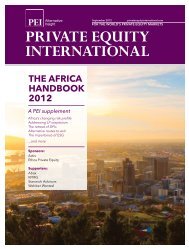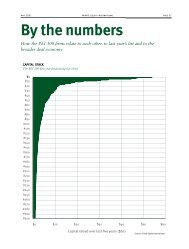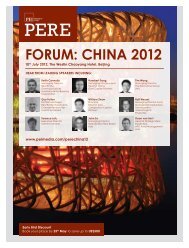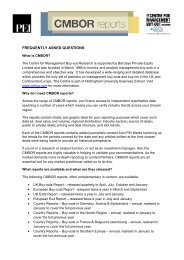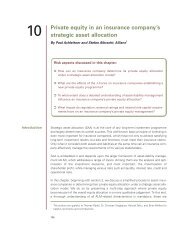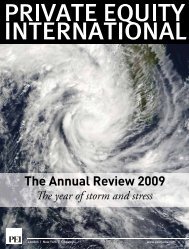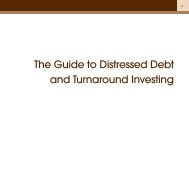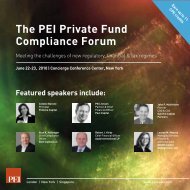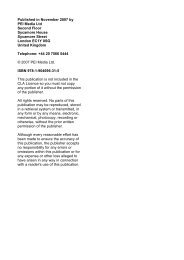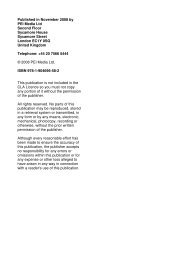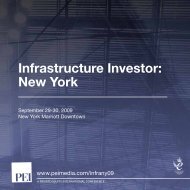ASIAtPACIFIC PRIVATE EQUITy REVIEW - PEI Media
ASIAtPACIFIC PRIVATE EQUITy REVIEW - PEI Media
ASIAtPACIFIC PRIVATE EQUITy REVIEW - PEI Media
Create successful ePaper yourself
Turn your PDF publications into a flip-book with our unique Google optimized e-Paper software.
asia-pacific<br />
private equity<br />
review<br />
march 2012
foreword<br />
With China regularly making headlines in business sections of major news outlets, incredible<br />
growth rates in India and booming demographics across the region, Asia-Pacific is<br />
increasingly becoming the centre of attention for many global investors. The region has<br />
witnessed amazing growth in private equity as the scope for investment increases in almost<br />
every sector. A larger number of international firms are moving into the region while<br />
the number of local shops is rising on an exponential level. This is not merely evidence<br />
of opportunistic companies expanding in the region to take advantage of the unique<br />
opportunities on offer but a deep-rooted shift in the level of influence Asia-Pacific has<br />
within global financial markets.<br />
China and India are not the only markets that are attracting the eyes of investors with<br />
Asia-Pacific becoming the second largest target region for private equity investment as<br />
institutional investors look for new markets to deploy their capital. In 2011 alone, the<br />
total amount of capital raised for the region increased by 23% to approximately $30<br />
billion. However, China remains the leader of the pack as the country witnessed a 700%<br />
increase in capital raised from $2 billion to $16 billion between 2009 and 2011.<br />
Private Equity International’s researchers and analysts have been monitoring the growing<br />
relevance of Asia-Pacific private equity markets with keen interest and we examine its<br />
status and prospects in this report. Our exceptional position at the heart of the alternative<br />
asset class has provided us with unique access to the leading players of the region.<br />
In order to present this regional report, we have gauged the attitude and opinions of<br />
the investment community and assessed both investor and fund manager sentiment<br />
towards Asia-Pacific private equity. Putting our results in the context of ongoing global<br />
economic uncertainty, we wanted to outline historical trends in the region as well as<br />
future outlooks and prospects.<br />
We hope that you find the <strong>PEI</strong> Asia-Pacific Private Equity Review an informative and<br />
interesting read.<br />
asia-pacific<br />
private equity<br />
review<br />
•<br />
foreword<br />
executive summary<br />
global fundraising<br />
asia-pacific fundraising<br />
asia-pacific outlook<br />
lp snapshot<br />
lp regional strategies<br />
Larry Oberfeld<br />
Senior Analyst<br />
Private Equity International<br />
contents<br />
ASIA-PACIFIC <strong>PRIVATE</strong><br />
EQUITY <strong>REVIEW</strong><br />
Director of Data Products<br />
Dan Gunner<br />
Tel: +44 20 7566 5423<br />
dan.g@peimedia.com<br />
01 Foreword<br />
02 Executive Summary<br />
Contributors<br />
Chua Sian Howe<br />
Koh Keling<br />
Wang Kai Li<br />
Chia Xin Ying<br />
Sales<br />
Adrian Przyborowski<br />
Tel: +44 20 7566 5476<br />
adrian.p@peimedia.com<br />
Chris Magnani<br />
Tel: +1 212 633 1074<br />
chris.m@peimedia.com<br />
Senior Analyst<br />
Larry Oberfeld<br />
Tel: +44 20 7566 5467<br />
larry.o@peimedia.com<br />
Head of Production<br />
Tian Mullarkey<br />
Tel: +44 20 7566 5436<br />
tian.m@peimedia.com<br />
Production and Design Manager<br />
Miriam Vysna<br />
Tel: +44 20 7566 5433<br />
miriam.v@peimedia.com<br />
06 Global Fundraising<br />
09 Asia-Pacific Fundraising<br />
17 Asia-Pacific Outlook<br />
20 LP Snapshot<br />
23 LP Regional Strategies<br />
page 1<br />
www.privateequityconnect.com
EXECUTIVE<br />
SUMMARY<br />
asia-pacific<br />
private equity<br />
review<br />
foreword<br />
executive summary<br />
•<br />
global fundraising<br />
About <strong>PEI</strong><br />
asia-pacific fundraising<br />
asia-pacific outlook<br />
lp snapshot<br />
lp regional strategies<br />
page 2<br />
<strong>PEI</strong> is the leading financial information group dedicated to the alternative asset classes<br />
of private equity, real estate and infrastructure globally. It is an independent company<br />
with over 100 staff based in four regional offices – London, New York, Hong Kong and<br />
Singapore – and is wholly owned by its management and employees.<br />
We publish five globally-recognised magazines alongside five news websites, manage<br />
an extensive set of databases dedicated to alternative assets, run 24 market-leading conferences<br />
globally, publish a library of over 25 specialist books and directories and have a<br />
significant training business.<br />
We have grown into a widely-known and highly-regarded media business that delivers<br />
detailed coverage of the key alternative asset classes of private equity, real estate and<br />
infrastructure. We have worked hard to build a reputation for top quality journalism that<br />
is written by our own staff and is delivered via accomplished print and digital channels.<br />
The same principles of accuracy, genuine market knowledge and excellence of delivery<br />
inform our data, events and specialist publication activities also.<br />
We have members of our award-winning editorial team sat in all four of our offices<br />
and likewise our conference business runs events based from each of our locations. Our<br />
multilingual data teams in each office are continually feeding and updating our online<br />
databases under the supervision of seasoned analysts. We feel strongly that the industries<br />
we cover are at once global and local – so to cover them effectively we must be able to<br />
connect with them in every market and in any time zone. We also expect to provide the<br />
most relevant information via a variety of channels, ensuring always that our clients value<br />
the insight and knowledge we provide them.<br />
www.privateequityconnect.com
The total<br />
amount of<br />
aggregate<br />
capital raised<br />
in Asia-Pacific<br />
is increasing<br />
as the region is<br />
being targeted<br />
by more GPs<br />
asia-pacific<br />
private equity<br />
review<br />
About the Survey<br />
foreword<br />
• executive summary<br />
global fundraising<br />
asia-pacific fundraising<br />
In generating the report, our team of researchers in Singapore have utilised information<br />
sourced from the Private Equity International Research Centre together with views collected<br />
from 64 Asia-based prominent and senior professionals.<br />
key findings:<br />
• Even though 2011 witnessed a slight increase in the amount of aggregate capital raised,<br />
global fundraising has not recovered to its pre-crisis level.<br />
• Fewer Asian funds closed in 2011 but the total amount of aggregate capital raised in the<br />
region has increased. Simultaneously, Asia is the second biggest region targeted by GPs.<br />
• The region continues to be the preferred region for Asian LPs in 2012 but there is a<br />
decrease in the overall appetite for private equity.<br />
• Top 3 preferred strategies in Asia are growth/expansion capital, venture capital and<br />
buyout funds.<br />
• The majority of Asia GPs spend shorter time fundraising than their global counterparts.<br />
• The LP-GP relationship is the most important factor affecting fundraising success,<br />
while LPs are more concerned with GP’s expertise.<br />
• China and India are the top two preferred markets with Indonesia and Vietnam identified<br />
by LPs as the next two hotspots.<br />
• Fund managers and institutional investors have diverse views in terms of what the<br />
appropriate fund size is.<br />
• Overall, TMT, manufacturing and energy sectors will be highly sought-after by Asia<br />
investors.<br />
asia-pacific outlook<br />
lp snapshot<br />
lp regional strategies<br />
page 3<br />
www.privateequityconnect.com
LP Survey Respondents<br />
Distribution of respondents, by institution<br />
type<br />
Distribution of respondents, by location<br />
asia-pacific<br />
private equity<br />
review<br />
n<br />
15.6% Asset Manager<br />
n<br />
9.4%<br />
Australia<br />
n<br />
6.3%<br />
Bank/Financial Services<br />
n<br />
9.4%<br />
China<br />
n<br />
6.3%<br />
Corporate<br />
n<br />
15.6% Hong Kong<br />
n<br />
3.1%<br />
Financial Institution<br />
n<br />
3.1%<br />
India<br />
foreword<br />
executive summary<br />
•<br />
global fundraising<br />
asia-pacific fundraising<br />
asia-pacific outlook<br />
n<br />
n<br />
n<br />
n<br />
n<br />
n<br />
n<br />
n<br />
18.8% Fund of Funds Manager<br />
3.1% Gatekeepers<br />
6.3% Government Agency<br />
3.1% Independent Firm<br />
15.6% Insurance Company<br />
3.1% Investment Firm<br />
15.6% Pension Fund<br />
3.1% Sovereign Wealth Fund<br />
n<br />
n<br />
n<br />
n<br />
n<br />
n<br />
n<br />
34.4% Japan<br />
3.1% Malaysia<br />
3.1% New Zealand<br />
3.1% Philippines<br />
6.3% Singapore<br />
9.4% South Korea<br />
3.1% Vietnam<br />
lp snapshot<br />
lp regional strategies<br />
Distribution of respondents, by current role<br />
Distribution of respondents, by AUM<br />
n<br />
6.3%<br />
Analyst<br />
n<br />
7%<br />
More than $150 billion<br />
n<br />
3.1%<br />
Chief Executive Officer (CEO)<br />
n<br />
3%<br />
$15.1 billion-$18 billion<br />
n<br />
3.1%<br />
Chief Operating Officer (COO)<br />
n<br />
7%<br />
$12.1 billion-$15 billion<br />
n<br />
3.1%<br />
Director<br />
n<br />
3%<br />
$9.1 billion-$12 billion<br />
n<br />
9.4%<br />
Fund Manager<br />
n<br />
7%<br />
$6.1 billion-$9 billion<br />
n<br />
31.3% Investment Manager<br />
n<br />
10%<br />
$3.1 billion-$6 billion<br />
n<br />
12.5% Investor Relations<br />
n<br />
37%<br />
$1.1 billion-$3 billion<br />
n<br />
18.8% Managing Director<br />
n<br />
10%<br />
$501 million-$1 billion<br />
n<br />
6.3%<br />
Partner<br />
n 17%<br />
$101 million-$500 million<br />
page 4<br />
n<br />
6.3%<br />
Vice President (VP)<br />
www.privateequityconnect.com
GP Survey Respondents<br />
Distribution of respondents, by institution<br />
type<br />
Distribution of respondents, by location<br />
n<br />
n<br />
n<br />
n<br />
n<br />
n<br />
n<br />
n<br />
25.0% Asset Manager<br />
3.1% Corporate<br />
3.1% Family Office<br />
3.1% Financial Institution Subsidiary/Division<br />
12.5% Independent Firm<br />
28.1% Investment Firm<br />
21.9% Private Equity Group Subsidiary<br />
3.1% Other<br />
n<br />
n<br />
n<br />
n<br />
n<br />
n<br />
n<br />
n<br />
n<br />
n<br />
n<br />
18.8% Australia<br />
3.1% China<br />
12.5% Hong Kong<br />
31.3% India<br />
6.3% Japan<br />
3.1% Kazakhstan<br />
3.1% New Zealand<br />
3.1% Singapore<br />
6.3% South Korea<br />
3.1% Taiwan<br />
9.4% Vietnam<br />
asia-pacific<br />
private equity<br />
review<br />
foreword<br />
• executive summary<br />
global fundraising<br />
asia-pacific fundraising<br />
asia-pacific outlook<br />
Distribution of respondents, by current role<br />
Distribution of respondents, by FUM<br />
lp snapshot<br />
lp regional strategies<br />
n<br />
n<br />
n<br />
n<br />
n<br />
n<br />
n<br />
n<br />
n<br />
n<br />
3.1% Analyst<br />
3.1% Associate<br />
3.1% Senior Associate<br />
3.1% Vice President<br />
18.8% Principal<br />
43.8% Partner<br />
6.3% Chief Financial Officer<br />
3.1% Controller<br />
3.1% Fund Marketing<br />
12.5% Investor Relations<br />
n 45.2% Less than 300 million<br />
n 22.6% 300 million - 750 million<br />
n 22.6% 750 million - 2 billion<br />
n<br />
n<br />
6.5%<br />
3.2%<br />
2 billion - 5 billion<br />
More than 5 billion<br />
page 5<br />
www.privateequityconnect.com
global<br />
fundraising<br />
asia-pacific<br />
private equity<br />
review<br />
Private equity activity has remained relatively stable<br />
since its peak in 2008<br />
foreword<br />
executive summary<br />
figure 1.1<br />
Aggregate capital<br />
raised by year<br />
$bn<br />
500<br />
400<br />
No<br />
500<br />
400<br />
global fundraising •<br />
300<br />
300<br />
asia-pacific fundraising<br />
200<br />
200<br />
asia-pacific outlook<br />
100<br />
100<br />
lp snapshot<br />
lp regional strategies<br />
0<br />
2008 2009 2010 2011<br />
0<br />
Source: Private Equity<br />
International Research Centre<br />
n Capital Raised ($bn)<br />
n Number of Closed Funds<br />
page 6<br />
Private equity activity witnessed a major decline between 2008 and 2009 as the onset<br />
of the global financial crisis led to a significant reduction in the number of funds closing,<br />
from 462 funds in 2008 to 305 funds in 2009. The $422 billion of capital raised in 2008<br />
is almost double that of the $212 billion raised in 2009.<br />
From 2009 to 2011, the private equity industry was marked by a period of market<br />
unpredictability and upheaval. Mounting fears over a global economic slowdown (an<br />
overheated economy in China, the sovereign debt crisis in Europe and debt ceiling debate<br />
in US) continue to weigh on investors’ minds and hamper growth in PE activity. The<br />
amount of capital raised by PE funds was significantly below its pre-crisis level and the<br />
number of funds closed during this period remained relatively stagnant, at an average<br />
of 315 funds. Globally, many limited partners cut back on re-ups in 2011 in an effort<br />
to reduce the number of total partnerships. Also, there is a reduction in the number of<br />
closed funds globally as many GPs were unable to raise new funds following difficulties<br />
in exiting their previous investments. Only some of the stronger firms have been able to<br />
come back upon committing 70 to 80 percent of their current funds.<br />
www.privateequityconnect.com
Buyouts dominate fundraising when analysed by strategy<br />
figure 1.2<br />
Breakdown of<br />
2011 fundraising<br />
by strategy<br />
$bn<br />
100<br />
90<br />
80<br />
70<br />
60<br />
50<br />
40<br />
No<br />
100<br />
80<br />
60<br />
40<br />
asia-pacific<br />
private equity<br />
review<br />
30<br />
20<br />
20<br />
10<br />
foreword<br />
0<br />
Buyout<br />
Growth/Expansion Capital<br />
Turnaround<br />
Venture Capital<br />
Mezzanine<br />
Secondaries<br />
Fund of Funds<br />
0<br />
executive summary<br />
• global fundraising<br />
asia-pacific fundraising<br />
asia-pacific outlook<br />
Source: Private Equity<br />
International Research Centre<br />
n Capital Raised ($bn)<br />
n Number of Closed Funds<br />
lp snapshot<br />
lp regional strategies<br />
A total of 303 private equity funds closed in 2011, raising $186 billion in capital. Of these,<br />
buyout funds recorded the highest amount of both capital raised and number of funds<br />
closed. Buyout, growth/expansion capital and distressed/turnaround funds comprised<br />
the top three strategies favoured by GPs in 2011.<br />
As seen in Figure 1.2, 94 buyout funds closed in 2011, raising a total of $78 billion.<br />
When compared to the $76 billion from 91 funds in 2010, the level of fundraising for<br />
buyouts remains relatively unchanged. One of the biggest buyout funds closed in 2011<br />
is the $6.4 billion EQT VI, managed by EQT Partners which targets Europe.<br />
Interestingly, there is an increasing trend in growth/expansion capital funds from<br />
2010 to 2011. Funds utilising this strategy garnered a total of $32 billion in 2011, which<br />
is $13 billion more than the amount raised over the previous year. EnCap Energy Capital<br />
Fund VIII alone makes up approximately 10 percent of the total capital raised in 2011.<br />
Hence, 2011 witnessed a good jump in aggregate amount raised.<br />
One reason for this trend is the lack of bank-based financing in many emerging countries.<br />
As a prominent Asian GP mentioned, private equity is becoming a key provider of<br />
growth capital for China’s small and medium-sized enterprises. He added that enterprises<br />
aim to expand but face challenges in raising funds amid fiscal tightening and uncertainty<br />
in the equity markets.<br />
page 7<br />
www.privateequityconnect.com
North America remains the largest region for capital<br />
raising<br />
figure 1.3<br />
asia-pacific<br />
private equity<br />
review<br />
Regional<br />
breakdown of<br />
2011 global<br />
capital raised<br />
foreword<br />
n<br />
36.2% North America<br />
executive summary<br />
n<br />
n<br />
12.2% Western Europe<br />
0.6% Central & Eastern Europe<br />
global fundraising •<br />
n<br />
n<br />
1.1% Middle East / Africa<br />
14.7% Asia-Pacific<br />
asia-pacific fundraising<br />
Source: Private Equity<br />
International Research Centre<br />
n<br />
n<br />
5.3% Latin America<br />
29.9% Funds targeting multiple regions<br />
asia-pacific outlook<br />
lp snapshot<br />
lp regional strategies<br />
page 8<br />
According to Figure 1.3, North America topped the list by securing 36 percent of total<br />
capital raised in 2011, followed by Asia-Pacific with 15 percent of global capital focused<br />
on this region.<br />
From 2010 to 2011, the amount of capital targeting Asia-Pacific experienced a slight<br />
increase from 14 percent to 15 percent. Private equity investments within Asia have<br />
become significantly pronounced in recent years as it has become increasingly difficult<br />
to source and complete deals in other regions, most notably in the US and Europe, due<br />
to mounting regulatory pressures, financial instability and unpredictable governments.<br />
According to the 2011 World Economic Forum’s Financial Development Report, Hong<br />
Kong displaced the US as the world’s top financial centre, scoring the highest ratings<br />
across seven criteria including institutional and business environment, financial stability,<br />
financial services and markets and financial access. As a result, Hong Kong and the region<br />
as a whole have increasingly become more enticing for investors, which is particularly<br />
helpful for fundraising in the region.<br />
The ongoing sovereign debt crisis in Europe also boosted private equity investments<br />
in Asia as many investors sought to minimise the currency risks associated with Eurodenominated<br />
funds, choosing to invest in USD or RMB-denominated funds instead.<br />
In addition, with the private equity benchmark showing a 13 percent net return over<br />
a 10 year period in developing Asia and a net return of 12 percent for the US, one USbased<br />
gatekeeper felt that Asia will continue to see an increase in capital flow due to the<br />
better returns that investors can derive from investing in the region.<br />
www.privateequityconnect.com
asia-pacific<br />
fundraising<br />
Asia-Pacific fundraising increased 23% in 2011…<br />
figure 2.1<br />
Aggregate capital<br />
of Asia-focused<br />
funds by year<br />
$bn<br />
50<br />
40<br />
No<br />
80<br />
70<br />
asia-pacific<br />
private equity<br />
review<br />
30<br />
60<br />
20<br />
foreword<br />
10<br />
50<br />
executive summary<br />
Source: Private Equity<br />
International Research Centre<br />
0<br />
2008 2009 2010 2011<br />
n Capital Raised ($bn)<br />
n Number of Closed Funds<br />
40<br />
global fundraising<br />
• asia-pacific fundraising<br />
asia-pacific outlook<br />
Fundraising targeting Asia-Pacific follows the same trend as global fundraising but presents<br />
a different outlook. Despite tumultuous global markets in recent years, private equity<br />
continued its pattern of growth across Asia-Pacific with Southeast Asia and China expected<br />
to see the highest degree of growth.<br />
Following the 2008 global financial crisis, private equity in Asia-Pacific emerged from<br />
the sharp contraction and raised a total of $24 billion from 76 funds in 2010.<br />
Total capital raised for 2011 was approximately $30 billion, amounting to a 23 percent<br />
increase on 2010. Surprisingly, even though the amount of total capital raised increased,<br />
the number of closed funds has dropped from 76 to 64 funds.<br />
An Asia-based fund manager expects to see the launch of bigger private equity funds<br />
in China, citing that successful GPs will launch funds targeting $2-$3 billion in commitments<br />
with a predominant focus towards investments in China or Pan-Asia. He also<br />
mentioned that consolidation is an inevitable process for China, but will not occur as<br />
quickly as people think.<br />
The fall in the number of closed funds indicates that fundraising is increasingly challenging<br />
as GPs compete for market share in a saturated environment.<br />
Although there is a steady increase in the amount of total aggregate capital raised<br />
targeting Asia-Pacific between 2009 and 2011, fundraising activity have yet to recover<br />
to its previous level before the global financial crisis as underlying uncertainties affect<br />
the investment climate.<br />
lp snapshot<br />
lp regional strategies<br />
page 9<br />
www.privateequityconnect.com
… as growth/expansion and venture capital are the<br />
most prevalent strategies<br />
asia-pacific<br />
private equity<br />
review<br />
figure 2.2<br />
Breakdown of<br />
2011 Asia-focused<br />
funds by strategy<br />
$bn<br />
12<br />
10<br />
8<br />
6<br />
4<br />
2<br />
No<br />
35<br />
30<br />
25<br />
20<br />
15<br />
10<br />
5<br />
foreword<br />
executive summary<br />
global fundraising<br />
asia-pacific fundraising •<br />
asia-pacific outlook<br />
Source: Private Equity<br />
International Research Centre<br />
0<br />
Growth/<br />
Expansion Capital<br />
Venture Capital<br />
Buyout/ Laterstage<br />
Turnaround/ Distressed<br />
n Capital Raised ($bn)<br />
n Number of Closed Funds<br />
Fund of Funds<br />
Secondaries<br />
Mezzanine/ Subordinated Debt<br />
0<br />
lp snapshot<br />
lp regional strategies<br />
page 10<br />
According to Figure 2.2, growth/expansion capital, venture capital and buyout funds<br />
represent the top three strategies adopted by GPs targeting Asia in 2011. A total of 14<br />
growth/expansion capital funds raised an aggregate amount of $12 billion. Simultaneously,<br />
32 venture capital funds raised $9 billion, followed by 11 buyout funds that accrued<br />
$7 billion.<br />
Globally, GPs generally followed the same strategies but have a preference for turnaround/distressed<br />
funds over venture capital. In 2011, venture capital funds comprised<br />
more than half of Asia-focused funds, while only 28 percent of global funds are categorized<br />
under the same strategy. Compared to other regions of the world, venture capital was a<br />
more popular strategy in Asia-Pacific.<br />
During the same period, there was an increase in total capital raised for growth/<br />
expansion funds. This was accounted for by the $12 billion raised from 14 funds in 2011<br />
as opposed to the $8 billion from 24 funds in 2010.<br />
We are seeing more capital raised from a smaller number of growth/expansion funds<br />
in 2011 than 2010. This trend indicates that the growth/expansion funds of Asia-Pacific<br />
are growing in size and becoming more established in the region. Many fund managers<br />
who successfully raised growth/expansion capital funds are returning to the market<br />
with larger funds. One example of such a fund manager is Orchid Asia. The GP previously<br />
raised $420 million for Orchid Asia Fund IV in 2007 and came back to the market<br />
closing $650 million for their fifth fund in 2011.<br />
www.privateequityconnect.com
38 percent of<br />
respondents<br />
are able to<br />
raise funds<br />
within 6 to 12<br />
months<br />
asia-pacific<br />
private equity<br />
review<br />
Asian GPs raise funds quicker than the average global<br />
fundraising period<br />
figure 2.3<br />
Fundraising period<br />
for Asian GPs<br />
Less than 6 months<br />
Less than 12 months<br />
Less than 18 months<br />
Less than 24 months<br />
24 months and above<br />
foreword<br />
executive summary<br />
global fundraising<br />
• asia-pacific fundraising<br />
asia-pacific outlook<br />
lp snapshot<br />
lp regional strategies<br />
%<br />
Source: <strong>PEI</strong> Surveys<br />
n Percentage of Respondents<br />
The ability to garner capital commitment from LPs within the shortest period of time<br />
is a key determinant of a GP’s success in terms of fundraising in a particular region. In<br />
2011, the average global fundraising period for private equity funds was approximately<br />
18 months.<br />
The majority of the Asian GPs are able to raise funds in a shorter amount of time than<br />
the average fundraising period for their global counterparts. Survey findings indicate that<br />
38 percent of respondents are able to raise funds within 6 to 12 months while only 16<br />
percent took 18 months and above. In 2011, China based Hony Capital closed its fifth<br />
USD-denominated fund on nearly $2.4 billion, with only 4 months of fundraising. In<br />
addition, WestBridge Capital Partners was also able to close its WestBridge Crossover<br />
Fund at $500 million in just six months of fundraising.<br />
However, not all fund managers share the same success in fundraising as about 6 percent<br />
of the respondents took more than 24 months to reach the final close for their funds.<br />
page 11<br />
www.privateequityconnect.com
asia-pacific<br />
private equity<br />
review<br />
I understand<br />
management<br />
fees have to<br />
be there to<br />
pay someone<br />
to manage the<br />
fund, but the<br />
fees must be<br />
flexible, not<br />
fixed<br />
The LP-GP relationship remains important<br />
foreword<br />
executive summary<br />
global fundraising<br />
asia-pacific fundraising •<br />
asia-pacific outlook<br />
lp snapshot<br />
lp regional strategies<br />
figure 2.4<br />
Factors influencing<br />
fundraising’s<br />
success<br />
Legal and<br />
regulatory<br />
environment<br />
No. of existing<br />
deals in market<br />
Availability of<br />
market capital<br />
LP–GP relationship<br />
Macro-environment<br />
Source: <strong>PEI</strong> Surveys<br />
n Average score<br />
page 12<br />
As shown in Figure 2.4, the LP-GP relationship, market capital availability and macroenvironment<br />
were rated as the top three factors affecting fundraising success.<br />
To maintain and improve relationships between LPs and GPs, it is important that<br />
communication and transparency exist between both parties. Apart from taking LPs’<br />
feedback into consideration, GPs should strive for transparency by making sure that any<br />
concerns regarding investment performance, management advancement, and strategy<br />
changes are made known to LPs. Management fees are also an influencing factor of the<br />
LP-GP relationship. GPs and LPs need to be able to work out an agreeable fee structure<br />
to align both parties’ interests.<br />
In order for Asia-based GPs to have better resilience against macro-weaknesses, they<br />
have to display their capabilities to survive in times of economic downturn. They need<br />
to show the ability to restructure their businesses quickly and convince LPs to invest<br />
with them.<br />
www.privateequityconnect.com
asia-pacific<br />
private equity<br />
review<br />
China dominates private equity fundraising in the region<br />
foreword<br />
figure 2.5<br />
Breakdown of<br />
2011 Asia-focused<br />
fundraising by<br />
country<br />
%<br />
60<br />
50<br />
40<br />
30<br />
20<br />
executive summary<br />
global fundraising<br />
• asia-pacific fundraising<br />
asia-pacific outlook<br />
lp snapshot<br />
lp regional strategies<br />
10<br />
0<br />
Australia<br />
China<br />
India<br />
Indonesia<br />
Japan<br />
Malaysia<br />
Mongolia<br />
South Korea<br />
Funds targeting<br />
multiple Asia countries<br />
Source: <strong>PEI</strong> Surveys<br />
n Percentage of Total Capital Raised 2011<br />
Figure 2.5 represents a breakdown of the Asia-focused funds targeting different countries<br />
in 2011. The top two countries that emerged as GP favorites are China and India, with<br />
57 percent of capital allocated to China and 12 percent to India.<br />
China experienced a boom in its private equity market between 2009 and 2011 as<br />
the amount of capital raised significantly increased from $2 billion to $16 billion, a 700<br />
percent increase on its previous years.<br />
In contrast, India witnessed slower growth with $2 billion aggregate capital raised in<br />
2009 and $3 billion raised at the end of 2011, an increase of 50 percent.<br />
page 13<br />
www.privateequityconnect.com
Country in Focus:<br />
China<br />
asia-pacific<br />
private equity<br />
review<br />
foreword<br />
executive summary<br />
global fundraising<br />
asia-pacific fundraising •<br />
asia-pacific outlook<br />
lp snapshot<br />
lp regional strategies<br />
While fundraising activities across the world are largely dominated by global firms with<br />
USD- denominated funds, there has been a dramatic shift in fundraising with the rise of<br />
RMB-denominated funds in China. Since 2007, the domestic private equity industry has<br />
grown exponentially with the introduction of the ‘Limited Partnership’ law that enabled<br />
the formation of RMB-denominated private equity funds. RMB fundraising reached $7<br />
billion in 2011, representing a 75 percent increase from the $4 billion raised in 2010.<br />
However, RMB fundraising is still behind USD-denominated funds, which raised $8<br />
billion in 2011.<br />
One reason for the increase in RMB fundraising is that the Chinese private equity<br />
industry is well supported by government related institutions, such as the China Investment<br />
Corporation (CIC) and National Council for Social Security Fund of China (NSSF), who<br />
are able to make very sizeable commitments allowing GPs who garner support from them<br />
to raise large funds. Figure 2.6 samples some of the largest funds targeting the country.<br />
page 14<br />
www.privateequityconnect.com
Consolidation is<br />
inevitable but in<br />
China the industry<br />
won’t consolidate as<br />
fast as people think<br />
figure 2.6<br />
Top 5 China RMB funds closed in 2011<br />
Fund Name Fund Manager Fund Size (m) Fund Strategy<br />
asia-pacific<br />
private equity<br />
review<br />
Hony Capital Hony PE RMB Fund II CNY 10,000 Buyout<br />
Tencent Holdings Limited Software Developers Fund CNY 10,000 Venture Capital<br />
YunFeng Capital YunFeng Capital Fund CNY 10,000 Venture Capital<br />
Cowin Capital South Sea Growth Fund V CNY 2,500 Venture Capital<br />
Shenzhen Oriental Fortune Capital Oriental Fortune Capital III CNY 2,500 Venture Capital<br />
US$1 = CNY 6.46<br />
Source: Private Equity International Research Centre<br />
Another factor leading to the success of RMB funds is the improved regulatory environment<br />
that makes it easier for foreigners to raise private equity funds, thus attracting<br />
many new investors into the market. Over half of the 10 biggest Chinese private equity<br />
deals in 2011 were carried out by overseas GPs which continue to play an active role<br />
in the market. Franklin Templeton Darby Private Equity, Partners Group and Goldman<br />
Sachs were among the several global private equity firms who launched RMB funds in<br />
2011. To these firms, RMB-denominated funds promise a simplified and faster approval<br />
process for completing deals in China as well as access to Chinese investors.<br />
Despite breaching regulations in 2011, a record number of private equity funds operate<br />
in China. However, the Chinese government is reacting proactively by putting best<br />
practice principles in place so as to remain competitive with developed markets. In late<br />
2011, the country’s National Development and Reform Commission (NDRC) released<br />
a measure requiring onshore private equity funds in Beijing, Shanghai, Tianjin, Jiangsu<br />
Province, Zhejiang Province and Hubei Province with more than RMB 500 million ($79<br />
million) of assets under management to register and submit fund information for review.<br />
This measure further adds to the confidence of LPs to invest in China.<br />
Currently, China occupies the most attractive and unique position in Asia-Pacific fundraising.<br />
The country is largely able to insulate from currency risks due to the emergence<br />
of RMB-denominated funds while the market has defied global fundraising trends and<br />
made significant advancements in the face of a gloomy fundraising climate. The popularity<br />
of RMB-denominated funds is expected to soar in 2012 due to demand from both<br />
domestic and global private equity firms.<br />
foreword<br />
executive summary<br />
global fundraising<br />
• asia-pacific fundraising<br />
asia-pacific outlook<br />
lp snapshot<br />
lp regional strategies<br />
page 15<br />
www.privateequityconnect.com
Country in Focus:<br />
india<br />
asia-pacific<br />
private equity<br />
review<br />
foreword<br />
executive summary<br />
global fundraising<br />
asia-pacific fundraising •<br />
asia-pacific outlook<br />
lp snapshot<br />
lp regional strategies<br />
India represents the second largest private equity market in Asia-Pacific, behind China. Fundraising<br />
for India-focused managers has stagnated below its 2008 peak of $8 billion. In 2010,<br />
23 funds were launched in India raising a total of $3 billion. 2011 was another difficult year<br />
for GPs raising India-focused funds, with about $2 billion raised by the end of the year from<br />
28 India-focused private equity funds. There are mixed views when it comes to the current<br />
state of the country’s private equity markets and one active investor shared his sentiments by<br />
stating that the global LP community is generally more discriminating when making decisions<br />
on the kind of Indian GPs and strategies that they will invest in. The perception that India is<br />
riskier and more challenging than other emerging markets remains a concern for many LPs<br />
and this could be the reason why the country experienced such growth.<br />
In addition, the amount of capital raised in the years preceding the global financial crisis has<br />
resulted in an abundance of capital within the country as the amount of dry powder available<br />
was more than enough to fund all deal activities for the next few years. As such, the private<br />
equity industry was saturated with capital that has yet to be deployed and fundraising efforts<br />
were minimal, having raised only $2 billion in 2009.<br />
Fundraising in India is also partly affected by a decreasing number of exits in the Indian<br />
domestic market. The internal rates of return (IRR) in India have also underperformed. For<br />
every approximate $5 billion of investments made during 1999 to 2010, the average IRR was<br />
18 percent. This figure is well below the benchmark of most investors, who require a gross<br />
IRR of 25 percent. LPs are beginning voice concerns about their private equity returns and<br />
adopting a more cautious behavior with future commitment.<br />
If the current trend continues into 2012, India’s private equity market may face challenges<br />
on several fronts, including a crowded playing field of GPs with a slower domestic economy,<br />
rising inflation and regulatory obstacles. In short, fundraising in India may be difficult for<br />
managers with short track records due to a high level of competition.<br />
However, despite market uncertainties, there are still positive signs from the Indian market.<br />
2011 witnessed a couple of private equity funds being over-subscribed, showing that GPs with<br />
the right fundamentals are still able to gain investors’ confidence, as seen in the figure below.<br />
figure 2.7<br />
Top 3 oversubscribed India funds closed in 2011<br />
Fund Name Fund Manager Target Fund<br />
Size ($m)<br />
Fund Closing<br />
Amount ($m)<br />
Fund Strategy<br />
Everstone Capital<br />
Partners II<br />
Everstone<br />
Capital<br />
330 580 Growth /<br />
Expansion Capital<br />
Edelweiss’ Special<br />
Opportunities Fund (ESOF)<br />
Edelweiss<br />
Capital<br />
200 230 Turnaround/<br />
Distressed<br />
page 16<br />
Multiples Private Equity<br />
Fund<br />
Multiples<br />
Alternate Asset<br />
Management<br />
400 450 Buyout<br />
www.privateequityconnect.com<br />
Source: Private Equity International Research Centre
asia-pacific<br />
outlook<br />
Buyout and venture capital/growth equity funds are<br />
preferred by GPs<br />
figure 3.1<br />
%<br />
Future fund appetite<br />
50<br />
40<br />
30<br />
20<br />
asia-pacific<br />
private equity<br />
review<br />
foreword<br />
executive summary<br />
global fundraising<br />
10<br />
0<br />
Buyout/Corporate PE<br />
Venture Capital/Growth Equity<br />
Mezzanine/Debt<br />
Fund of Funds/Co-investment<br />
Distressed/Turnaround<br />
Secondaries<br />
asia-pacific fundraising<br />
• asia-pacific outlook<br />
lp snapshot<br />
lp regional strategies<br />
Source: <strong>PEI</strong> Surveys<br />
n<br />
n<br />
n<br />
North America<br />
Western Europe<br />
Central & Eastern Europe<br />
n<br />
n<br />
n<br />
Middle East<br />
Africa<br />
Asia-Pacific<br />
Most GPs will choose to raise buyout (44 percent), venture capital and growth/equity<br />
(47 percent) funds in 2012, according to Figure 3.1. Simultaneously, about 6 percent of<br />
respondents indicated that they will utilize either mezzanine, distressed/turnaround or<br />
secondaries fund strategies.<br />
GPs’ future appetites are consistent with current fundraising strategy trends in Asia.<br />
After seeing a spike in venture capital investments in 2011, Asia may continue to see an<br />
increase in venture capital/growth equity, particularly in China. In the 2012 version of<br />
‘Catalogue for Guidance of Foreign Investment in Industry’, all foreign investments are<br />
classified into the “encouraged”, “restricted”, “prohibited” and “permitted” categories.<br />
Venture capital is specifically listed as one of the encouraged strategies for investors in<br />
the country.<br />
page 17<br />
www.privateequityconnect.com
asia-pacific<br />
private equity<br />
review<br />
“Funds raised<br />
in Asia are<br />
getting too<br />
large with<br />
the rapid<br />
scale up of<br />
funds moving<br />
managers out<br />
of their comfort<br />
zones.”<br />
foreword<br />
executive summary<br />
global fundraising<br />
asia-pacific fundraising<br />
asia-pacific outlook<br />
•<br />
lp snapshot<br />
lp regional strategies<br />
GPs interested in raising smaller funds…<br />
figure 3.2<br />
Future target<br />
fund size<br />
Less than $250M<br />
$250M to $500M<br />
$500M to $1B<br />
$1B to $5B<br />
$5bn and above<br />
%<br />
Source: <strong>PEI</strong> Surveys<br />
page 18<br />
When asked about their target size for private equity fundraising over the next 12 months,<br />
almost half of the GPs surveyed expressed an interest in raising fund/s targeting no more<br />
than $250 million in fund size. This was followed by 35 percent of GPs who have a target<br />
fund size of $250 to $500 million. In comparison, only 17 percent of the respondents<br />
seek to raise bigger funds targeting more than $500 million.<br />
One investor pointed out that there is a rapid scale up in fund size. This is driving GPs<br />
out of their comfort zone, where very large funds have to seek limited buyout opportunities<br />
resulting in GPs’ intention to raise smaller funds.<br />
www.privateequityconnect.com
… however, LPs expect funds to be larger<br />
figure 3.3<br />
LPs’ perceived<br />
appropriate<br />
fund size<br />
n<br />
n<br />
n<br />
n<br />
n<br />
9.1%<br />
40.9%<br />
36.4%<br />
9.1%<br />
4.5%<br />
Less than $250M<br />
$250M to $500M<br />
$500M to $1B<br />
$1B to $5B<br />
$5B and above<br />
Source: <strong>PEI</strong> Surveys<br />
asia-pacific<br />
private equity<br />
review<br />
A vast majority of institutional investors believe that an appropriate fund size should lie<br />
within the range of $250 million to $500 million while about one-third feel that it should<br />
be within the $500 million to $1 billion range. This finding may be alarming to GPs who<br />
are planning to raise relatively smaller private equity funds as it indicates a divergence<br />
between the expectations of LPs and GPs.<br />
foreword<br />
executive summary<br />
global fundraising<br />
With fund sizes getting bigger over the years, 40 percent of<br />
the LPs surveyed felt that Asia private equity funds are getting<br />
too large. Reasons provided include:<br />
• There is too much interest in Asia.<br />
• Asian GPs have a size complex where they think that<br />
bigger funds are better.<br />
• Asian investors observing the market are less sophisticated<br />
than those in North America and Western Europe<br />
and believe that the size of a fund is an indication of<br />
success, thus creating a vicious cycle where they do not<br />
criticise overambitious GPs.<br />
• There are too many managers in Asia with limited track<br />
records.<br />
• There are too many GPs in Asia who are backed by<br />
relationships and re-ups driven by Western institutions.<br />
asia-pacific fundraising<br />
• asia-pacific outlook<br />
lp snapshot<br />
lp regional strategies<br />
As a whole, fundraising has proved to be difficult for global GPs in 2011 as there<br />
have been no major improvements witnessed over the year. Although fundraising shows<br />
a steady increase in total aggregate capital raised throughout 2009 to 2011, fundraising<br />
activities have not yet recovered to their pre-global financial crisis level. Asian fund<br />
managers will have to continue battling in a crowded market for available capital, manage<br />
the LP-GP relationship effectively and prepare themselves for any changes in the global<br />
macro-environment.<br />
page 19<br />
www.privateequityconnect.com
LP snapshot<br />
asia-pacific<br />
private equity<br />
review<br />
Globally, pension funds and foundations/endowments<br />
comprise the largest category of institutional investors.<br />
However, in Asia-Pacific, corporates are the most active<br />
figure 4.1<br />
Breakdown of institutional investors<br />
foreword<br />
executive summary<br />
global fundraising<br />
asia-pacific fundraising<br />
asia-pacific outlook<br />
lp snapshot<br />
•<br />
lp regional strategies<br />
Asset Manager<br />
Bank/Financial Services<br />
Corporate<br />
Corporate Pension Fund<br />
Corporate Subsidiary/Division<br />
Family Office<br />
Foundation/Endowment<br />
Fund of Funds Manager<br />
Government Agency<br />
Independent Firm<br />
Insurance Company<br />
Investment Firm<br />
Other<br />
Pension Fund<br />
Sovereign Wealth Fund<br />
%<br />
n Global LPs<br />
n Asian LPs<br />
Source: Private Equity International Research Centre<br />
page 20<br />
The Private Equity International Research Centre profiles a diverse base of LPs across seven<br />
regions. Asian LPs make up 15 percent of the 3683 active institutional investors in private<br />
equity.<br />
Pension funds, foundation/endowments and investment firms constitute 50 percent<br />
of global institutional investors. Interestingly, the largest percentage of Asia based LPs are<br />
comprised of corporate (29 percent), bank/financial services (12 percent) and pension<br />
funds (12 percent). Corporate investors are far less prevalent in other regions making<br />
up only 2 percent of all the global LPs. Although global LPs are overwhelmingly foundation/endowments,<br />
they only constitute to a small portion of Asia institutional investors.<br />
www.privateequityconnect.com
The increase<br />
in allocation<br />
to Asian funds<br />
is due to the<br />
higher riskadjusted<br />
returns<br />
associated with<br />
investments in<br />
private equity<br />
asia-pacific<br />
private equity<br />
review<br />
foreword<br />
figure 4.2<br />
Sample of LPs commitments to 2011 closed funds<br />
Asia based LPs Fund Commitments Fund Strategy Fund Regions<br />
National Council for Hony PE RMB Fund II (Beijing Buyout<br />
Asia-Pacific<br />
Social Security Fund<br />
of China<br />
Hony 2010 Private Equity<br />
Investment Centre)<br />
Tokio Marine Asset IPV Capital II Venture Capital Asia-Pacific<br />
Management Co. Ltd<br />
Indian Overseas Bank Multiples Private Equity Fund Buyout Asia-Pacific<br />
executive summary<br />
global fundraising<br />
asia-pacific fundraising<br />
asia-pacific outlook<br />
• lp snapshot<br />
lp regional strategies<br />
Ping An Insurance<br />
Primavera Capital Fund<br />
Growth /<br />
Asia-Pacific<br />
(Group) Co. of China<br />
(Chunhua Fund)<br />
Expansion Capital<br />
National Pension<br />
Orix Korean Private Equity<br />
Growth /<br />
Asia-Pacific<br />
Service of Korea<br />
Fund<br />
Expansion Capital<br />
Source: Private Equity International Research Centre<br />
Figure 4.2 illustrates some Asian LPs’ commitments to Asia-focused private equity<br />
funds that have successfully closed in 2011. With private equity on the rise in Asia-Pacific,<br />
investors are increasingly ramping up activity in the region.<br />
The attractiveness of business opportunities that Asia offers as an investment destination<br />
has enticed foreign investors to inject capital into regional funds. One significant<br />
commitment made to Asia-focused funds closed in 2011 was by the Canada Pension Plan<br />
Investment Board that committed $100 million to Multiples Private Equity Fund. Qiming<br />
Venture Partners’ third China focused fund, which held its final close in May 2011, also<br />
garnered support from several foreign LPs including Siguler Guff, Robert Wood Johnson<br />
Foundation, Grove Street Advisors, Harvard University Endowment and University of<br />
Texas Investment Management Company.<br />
page 21<br />
www.privateequityconnect.com
asia-pacific<br />
private equity<br />
review<br />
Allocation<br />
to private<br />
equity funds<br />
will remain<br />
small due to<br />
limitations on<br />
so-called “riskassets”<br />
based<br />
upon assetallocation<br />
policy<br />
foreword<br />
executive summary<br />
global fundraising<br />
asia-pacific fundraising<br />
asia-pacific outlook<br />
lp snapshot<br />
•<br />
Majority of LPs plan to commit less than $250 million to<br />
private equity<br />
lp regional strategies<br />
figure 4.3<br />
Amount of capital<br />
to be committed<br />
in 2012<br />
n<br />
n<br />
n<br />
70.4%<br />
25.9%<br />
3.7%<br />
Less than $250M<br />
$250M to $500M<br />
$1B to $5B<br />
Source: <strong>PEI</strong> Surveys<br />
page 22<br />
With 2011 being an active year for Asia private equity, the need to understand LPs’ attitude<br />
towards future capital commitments in the asset class is inevitably an important factor<br />
as it is one of the many indicators of investors’ confidence towards the asset class. As<br />
mentioned earlier, there are diverse views and expectations from both fund managers<br />
and investors with regards to the appropriate size for a private equity fund to be raised<br />
in Asia. Figure 4.3 classifies the 32 respondents into 3 main groups with more than 70<br />
percent of LPs planning to commit less than $250 million to the asset class in 2012 and<br />
26 percent of them willing to commit between $250 million to $500 million.<br />
www.privateequityconnect.com
LP Regional<br />
Strategies<br />
Asia-Pacific is in demand<br />
asia-pacific<br />
private equity<br />
review<br />
figure 5.1<br />
Asian-based LPs<br />
current regional<br />
allocation<br />
%<br />
50<br />
40<br />
30<br />
20<br />
foreword<br />
executive summary<br />
global fundraising<br />
asia-pacific fundraising<br />
10<br />
asia-pacific outlook<br />
0<br />
North America<br />
Western Europe<br />
Central & Eastern Europe<br />
Middle East/Africa<br />
Asia-Pacific<br />
Latin America<br />
No Appetite<br />
lp snapshot<br />
• lp regional strategies<br />
Source: Private Equity<br />
International Research Centre<br />
n Current Allocation<br />
n Future Appetite<br />
Asia-Pacific remains the most attractive region for both current investments and future<br />
appetite in the alternative asset class according to Asian-based LPs. However, we see a<br />
decrease in investors’ appetite for North America and Asia which may be partly caused<br />
by the increase in investors with no appetite to invest in private equity at all over the<br />
next 12 months. One reason for the lack of LPs’ appetite is their overexposure to private<br />
equity investments as some went beyond their target allocation. On the other hand, some<br />
investors also stated that market instability and illiquidity associated with the asset class<br />
are contributing factors as to why they have decided to cease making new investments.<br />
Although there is an increase in investors’ unwillingness to commit further capital<br />
into private equity, Figure 5.2 illustrates an uptrend in terms of their future appetite<br />
towards emerging markets according to our survey respondents.<br />
page 23<br />
www.privateequityconnect.com
LPs are shifting their preference to emerging markets<br />
asia-pacific<br />
private equity<br />
review<br />
figure 5.2<br />
LPs’ current and<br />
future regional<br />
focus<br />
%<br />
100<br />
80<br />
60<br />
40<br />
foreword<br />
20<br />
executive summary<br />
global fundraising<br />
asia-pacific fundraising<br />
asia-pacific outlook<br />
lp snapshot<br />
lp regional strategies<br />
•<br />
Source: <strong>PEI</strong> Surveys<br />
0<br />
North America<br />
Western Europe<br />
Central & Eastern Europe<br />
n Current Investment/s<br />
n Future Investment/s<br />
Middle East<br />
Africa<br />
Asia Pacific<br />
Latin America<br />
With investor interest in Asia-Pacific remaining prominent, the trend of shifting appetite<br />
from developed to emerging markets continues.<br />
page 24<br />
Emerging Asian markets<br />
With China clearly standing out as Asia’s most popular market, there are opportunities<br />
offered by surrounding economies within the region that are attracting growing amounts<br />
of investments. In 2011, China-ASEAN Investment Fund announced its plans to raise a<br />
fund up to three times the size of its current $1 billion Southeast Asia fund, as LPs look<br />
to increase their exposure to the region. In the same year, Maybank launched its $500<br />
million clean energy fund with a focus on China, India, Indonesia, Malaysia, Thailand,<br />
the Philippines, Vietnam, Cambodia and Laos. Countries like the Philippines, Thailand,<br />
Cambodia and Laos are not typically the most popular destinations for private equity<br />
investors. However, some firms are finding success in these economies and others identifying<br />
emerging Asian markets to offer significant growth potential.<br />
www.privateequityconnect.com
Significant increase in interest for Indonesia and Vietnam<br />
figure 5.3<br />
%<br />
LPs’ current<br />
and future<br />
country-specific<br />
strategies<br />
Source: <strong>PEI</strong> Surveys<br />
30<br />
25<br />
20<br />
15<br />
10<br />
5<br />
0<br />
Australia<br />
Cambodia<br />
n Current Investment/s<br />
n Future Investment/s<br />
China<br />
Hong Kong<br />
India<br />
Indonesia<br />
Japan<br />
Laos<br />
Malaysia<br />
Philippines<br />
Singapore<br />
South Korea<br />
Taiwan<br />
Thailand<br />
Vietnam<br />
I have not invested<br />
in any Asia-Pacific fund<br />
Figure 5.3 illustrates a further breakdown of investor’s investment strategies within the<br />
Asia-Pacific region. China, India and Australia remain the top 3 preferred markets for<br />
private equity investments in 2012. However, interest in these 3 countries is declining<br />
as LPs reduce their appetite for these markets. Simultaneously, LPs’ interest in Japan has<br />
fallen by 6 percent. Following the Tohoku Earthquake, some LPs are more prudent in<br />
making investments in Japan as an element of uncertainty remains. Although China and<br />
India have captured investors’ attention from 2010 to 2011, investments in these two<br />
countries are diminishing as more Asian LPs are looking to divest their interests and<br />
seek new opportunities.<br />
Concurrently, the reduction in appetite for private equity investments in China and<br />
India contrasted with the increase in interest for Southeast Asia showing that investors’<br />
sentiment towards China and India is declining in favour of Southeast Asia.<br />
Foreign GPs such as Dubai-headquartered private equity firm Abraaj Capital also<br />
expressed interest in Southeast Asia by setting up an office in Singapore to utilise opportunities<br />
offered by the region.<br />
Another trend observed from the survey results is that a significant number of investors<br />
are willing to explore new opportunities in countries which currently have no<br />
exposure. Seven out of eight countries highlighted by respondents are in the Southeast<br />
Asia region, indicating a growing interest for the region. These countries are Cambodia,<br />
Laos, Malaysia, Philippines, Singapore, Thailand and Vietnam. Vietnam topped the list<br />
with the largest number of responses among the eight countries.<br />
asia-pacific<br />
private equity<br />
review<br />
foreword<br />
executive summary<br />
global fundraising<br />
asia-pacific fundraising<br />
asia-pacific outlook<br />
lp snapshot<br />
• lp regional strategies<br />
page 25<br />
www.privateequityconnect.com
indonesia<br />
asia-pacific<br />
private equity<br />
review<br />
Indonesia is likely to become one of<br />
the most important emerging markets<br />
for private equity in the next decade,<br />
driven by strong and sustainable economic<br />
fundamentals, favourable demographics and<br />
significant excess demand for equity capital<br />
foreword<br />
executive summary<br />
global fundraising<br />
asia-pacific fundraising<br />
asia-pacific outlook<br />
lp snapshot<br />
lp regional strategies<br />
•<br />
Out of all the Southeast Asia countries, Indonesia is identified as next hotspot for private<br />
equity investments over the next 12 months due to Indonesia’s low GDP per capita and<br />
accelerating growth, which increases the appeal of the country in the eyes of investors.<br />
As more LPs and GPs look to invest in Indonesia, the list of private equity funds targeting<br />
the country has consistently grown in recent years.<br />
figure 5.4<br />
Sample of Indonesia-focused funds<br />
that are currently in the market<br />
Fund Name Fund Manager Fund Strategy Target Fund<br />
Size ($m)<br />
Saratoga Asia III Saratoga Asia III Buyout 450<br />
Falcon House Partners<br />
Indonesia Fund 1<br />
Falcon House Partners<br />
Growth / Expansion<br />
Capital<br />
200<br />
Java Fund Yawadwipa Companies Buyout 1000<br />
Source: Private Equity International Research Centre<br />
page 26<br />
Figure 5.4 showcases a few Indonesia-focused funds recently launched in the market.<br />
Yawadwipa Companies in particular, has garnered attention as it was established by<br />
former Bank of America executive Christopher Holm, who committed $25 million to<br />
the fund. Besides the country’s economic factors, the success of Northstar Pacific Capital<br />
in exceeding its target and close its third fund on $820 million may also send a message<br />
out to all GPs that raising funds targeting Indonesia is a possible route to embark on.<br />
Notably, this fund is the largest fund ever raised for Indonesia.<br />
Hong Kong based CLSA Capital Partners has also been actively closing deals in Indonesia.<br />
In 2011, it invested $15 million in PT SariWangi AEA, one of Indonesia’s largest<br />
tea companies. This transaction was made just one week after it bought a minority stake<br />
in PT Sinar Mitra Depadan Finance (SMS Finance) for $20 million.<br />
www.privateequityconnect.com
asia-pacific<br />
private equity<br />
review<br />
foreword<br />
executive summary<br />
Country in Focus:<br />
vietnam<br />
Vietnam’s economy offers challenges due to corruption, which at one stage was considered<br />
to be the biggest obstacle towards private equity investments in the country. Now<br />
macroeconomic problems including a depreciating currency, close to 20 percent inflation,<br />
plunging property prices, increasing commercial lending rates, a more than 20 percent<br />
stock market decline and risks in the banking sector adversely affect the investment climate.<br />
However, valuations are coming down and multinationals are going into the country<br />
to buy again. 2011 provided some encouraging signs for the country with KKR’s $159<br />
million stake in Masan Consumer putting Vietnam on the private equity radar once again.<br />
In the same year, eight Vietnam-targeted funds were launched. The largest was Saigon<br />
Asset Management growth capital fund targeting $300 million. According to the 2011<br />
World Bank Ease of Doing Business ranking, Vietnam has improved its overall position<br />
from 88 to 78, being one of the top ten most improved economies. This is due to several<br />
reforms introduced by the Vietnamese government which made it easier for investors<br />
to obtain credit and start a business, therefore creating a more favourable environment.<br />
However, it is important to note that not all investors find Vietnam focused funds<br />
appealing. One Singapore based investor shared his views on Vietnam’s private equity<br />
market. He pointed out that the current existing macroeconomic problems are what<br />
investors have to look into before making any commitments.<br />
global fundraising<br />
asia-pacific fundraising<br />
asia-pacific outlook<br />
lp snapshot<br />
• lp regional strategies<br />
page 27<br />
www.privateequityconnect.com
“A GP must be<br />
truly capable”<br />
GP expertise in the region remains crucial<br />
There are other factors which investors look into before committing to a private equity<br />
fund as a wrong judgement may bring about massive losses given the current volatile<br />
market conditions.<br />
asia-pacific<br />
private equity<br />
review<br />
foreword<br />
executive summary<br />
global fundraising<br />
asia-pacific fundraising<br />
asia-pacific outlook<br />
figure 5.5<br />
Factors driving<br />
LPs to invest in<br />
a fund<br />
Source: <strong>PEI</strong> Surveys<br />
GP expertise in the region<br />
Previous fund performance<br />
Local LP investment<br />
LP-GP relationship<br />
Firm governance<br />
GP commitment to the<br />
fund<br />
Team stability (in the GP<br />
firm)<br />
n Average Score<br />
lp snapshot<br />
lp regional strategies<br />
•<br />
page 28<br />
As seen in Figure 5.5, the majority of the respondents felt that GPs’ expertise in the<br />
region is the most crucial factor affecting their decision to invest in a fund, showing that<br />
LPs are concerned about GPs’ track records. According to a member of the private equity<br />
industry, this is especially crucial in Asia due to the “limited supply of experienced general<br />
partners”. Ideally, LPs like to see managers who have gone through several business cycles,<br />
including the 1997 Asian crisis, along with a stable senior team. Also, GPs need to have<br />
strong local footprints and networks combined with international standard corporate<br />
governance in order to gain LPs’ trust.<br />
With no prior track record, GPs raising their debut funds are facing increasing difficulties<br />
as the current economic outlook is filled with uncertainties and LPs are far<br />
more careful in their assessment of GPs. It is tough for first-time funds to raise capital<br />
as many LPs simply do not consider inexperienced fund managers. To succeed, it is<br />
vital for GPs raising such funds to find ways to differentiate themselves from other new<br />
entrants in the market.<br />
Out of the 7 factors given, investors are least concerned with local LP investment and<br />
instead they are more focused on GPs’ commitment to the fund, previous fund performance<br />
and firm governance.<br />
With more than 80 percent of the investors indicating their preference to continue<br />
their existing relationships with GPs, LPs are more comfortable with investing in GPs<br />
they have established connections with. However, this is taking into account that GPs’<br />
performance and strategies are consistent with their track record.<br />
www.privateequityconnect.com
Market<br />
volatility and<br />
uncertainty<br />
are the main<br />
reason for a<br />
decrease in<br />
allocation to<br />
private equity<br />
funds<br />
asia-pacific<br />
private equity<br />
review<br />
foreword<br />
executive summary<br />
Interest in Asia-Pacific to continue<br />
figure 5.6<br />
Expected<br />
private equity<br />
allocation over<br />
the next 12<br />
months<br />
global fundraising<br />
asia-pacific fundraising<br />
asia-pacific outlook<br />
lp snapshot<br />
• lp regional strategies<br />
Source: <strong>PEI</strong> Surveys<br />
n<br />
n<br />
n<br />
34.5%<br />
55.2%<br />
10.3%<br />
Increase my allocation to PE funds<br />
Leave my allocation to PE funds unchanged<br />
Decrease my allocation to PE funds<br />
About 90 percent of investors surveyed plan to either keep the level of allocation to<br />
private equity funds unchanged or have plans to increase their allocation to the asset<br />
class. One reason for investors to maintain their current allocations to private equity is<br />
partly due to the need to review their portfolio allocation. In addition, some investors<br />
perceive private equity as “risky assets” and hence are not keen to increase their allocation.<br />
About 10 percent of the investors surveyed are seeking to decrease their allocation<br />
citing market volatility, uncertainties and regulatory reasons.<br />
page 29<br />
www.privateequityconnect.com
LPs are shifting their preference to emerging markets<br />
asia-pacific<br />
private equity<br />
review<br />
figure 5.7<br />
LPs’ current and<br />
future regional<br />
focus<br />
%<br />
n<br />
n<br />
n<br />
n<br />
n<br />
n<br />
North America<br />
Western Europe<br />
Central & Eastern Europe<br />
Africa<br />
Asia-Pacific<br />
Latin America<br />
35<br />
foreword<br />
30<br />
executive summary<br />
25<br />
global fundraising<br />
20<br />
asia-pacific fundraising<br />
asia-pacific outlook<br />
lp snapshot<br />
lp regional strategies<br />
•<br />
Source: Private<br />
Equity International<br />
Research Centre<br />
15<br />
10<br />
5<br />
0<br />
Buyout/Corporate PE<br />
Distressed/Turnaround<br />
Fund of funds/Co-investments<br />
Mezzanine/Debt<br />
Secondaries<br />
Venture Capital/Growth Equity<br />
page 30<br />
On a global basis, 30 percent of those surveyed prefer to invest in buyout/corporate<br />
private equity funds followed by 18 percent targeting distressed/turnaround funds in<br />
2012. Both secondaries and venture capital/growth equity strategies have 17 percent of<br />
the investors citing an interest in them on a global basis.<br />
In terms of global fundraising appetite, GPs also listed buyout/corporate private<br />
equity, venture capital/growth equity and distressed/turnaround as the top three fund<br />
types they seek to raise in 2012, indicating that LPs’ and GPs’ views on the market are<br />
generally aligned.<br />
Narrowing down to Asia, fund of funds/co-investments was highlighted by LPs as a<br />
strategy they are keen to invest in with a 12 percent allocation. The attraction to fund of<br />
funds lies in the fact that it is able to provide investors with diversification across different<br />
strategies and sectors without them having to commit to several funds.<br />
www.privateequityconnect.com
Biotech/Life sciences and clean tech/renewable sectors<br />
are perceived as having the best opportunity<br />
figure 5.8<br />
Sectors<br />
Biotech / Life Science<br />
GPs<br />
LPs<br />
asia-pacific<br />
private equity<br />
review<br />
Clean Tech / Renewable<br />
Energy / Oil & Gas<br />
Financial Services<br />
Leisure / Entertainment<br />
Manufacturing<br />
Natural Resources<br />
foreword<br />
executive summary<br />
global fundraising<br />
Retail<br />
asia-pacific fundraising<br />
TMT (Telecommunication, <strong>Media</strong>,<br />
Technology)<br />
asia-pacific outlook<br />
Transport<br />
lp snapshot<br />
Diversified<br />
• lp regional strategies<br />
n Current Investment/s<br />
n Future Investment/s<br />
n Current Investment/s<br />
n Future Investment/s<br />
%<br />
Source: <strong>PEI</strong> Surveys<br />
Figure 5.8 displays surveyed investors’ sector preferences. On a global basis, most of the<br />
LPs surveyed currently adopt a diversified approach in terms of sector preferences with<br />
about the same proportion of investors preferring such a strategy in 2012. 24 percent<br />
show a preference for biotech/life science and clean tech/renewable sectors which<br />
are perceived by LPs as offering the best opportunities followed by TMT and financial<br />
services with 20 percent each.<br />
Similarly, when the GPs were asked about their preferred sectors to invest in, it aligned<br />
with LPs’ future appetite with the exception of the manufacturing sector which stood<br />
out as the most sought after sector in 2012.<br />
As Asia-Pacific continues to be the most preferred region for investment from both LPs<br />
and GPs perspectives, the region’s attractiveness plays an important part in influencing<br />
page 31<br />
www.privateequityconnect.com
asia-pacific<br />
private equity<br />
review<br />
Some GPs are<br />
hired only based<br />
on their parents’<br />
position in the<br />
government and<br />
are not capable.<br />
You need to<br />
develop talent.<br />
Find GPs who<br />
10–20 years from<br />
now will be the<br />
backbone of this<br />
industry<br />
foreword<br />
executive summary<br />
global fundraising<br />
asia-pacific fundraising<br />
asia-pacific outlook<br />
lp snapshot<br />
lp regional strategies<br />
•<br />
page 32<br />
investors’ sector preferences. The TMT and manufacturing sectors remain the most desired<br />
sectors for future GP investments. This should not come as a surprise given the huge<br />
amount of growth opportunities within the region.<br />
China, the largest exporter of goods in the world, has witnessed an unprecedented<br />
growth in its manufacturing sector. Demand for the country’s products soared in light of<br />
the mass development taking place within its domestic economy along with the insatiable<br />
appetite for imports of Chinese goods by many developed countries.<br />
The TMT sector also witnessed a similar trend as the Chinese government embarked<br />
on efforts to improve the living standards of citizens while trying to create an attractive<br />
and conducive business environment. Moving forward, new guidelines by China’s National<br />
Development and Reform Commission (NDRC) published in January 2012 also encourage<br />
foreign investments into manufacturing upgrades and service industry sectors.<br />
In India, technology sector investments between 2004 and 2009 totaled about $3<br />
billion. It is estimated that between 2010 and 2015, $8 billion will be directed towards<br />
technology venture investments. India’s manufacturing sector is also gaining recognition<br />
for its high value goods. For instance, the export opportunity of Indian auto components<br />
is expected to reach $25 billion by year 2015.<br />
The Asian energy industry is growing in importance for many investors as China’s<br />
burgeoning economy and rapidly increasing population require more power. US headquartered<br />
energy specialist First Reserve Corporation signaled its commitment to Asia when<br />
it opened its first regional office in Hong Kong in 2011. Australian group AMP Capital<br />
made its first energy related investment with its Asian Giants Infrastructure Fund in<br />
China purchasing a 19 percent stake in Qujing Gas. India has also recorded some recent<br />
energy related deals with Australian bank Macquarie signing a $130 million deal backing<br />
a thermal power development project in Central India.<br />
www.privateequityconnect.com
Private Equity Connect is a unique multi-layered intelligence service from the<br />
Private Equity International team. This fundraising and investor relations tool<br />
will help you track investors and ease your access to capital.<br />
• Access over 3,600 investor profiles, over 3,900 fund<br />
manager profiles and 200 investment consultants<br />
• Not just facts and figures – each profile is linked with<br />
editorial insight from Private Equity International,<br />
presenting unique insight into investor motives<br />
• Flexible search terms allowing you to access information<br />
customised to your daily business needs<br />
• Dedicated research teams in London, New York, and<br />
Hong Kong in constant contact with institutional investors,<br />
ensuring accurate, reliable and<br />
up-to-date information<br />
PLUS: An integrated Analytics tool<br />
allowing you to track global fundraising<br />
trends by fund size, strategies and<br />
geographic investment focus<br />
Start your free 7 day trial today<br />
Contact us to discuss how<br />
Private Equity Connect can<br />
work for your organisation:<br />
Joss Onion in London<br />
on +44 (0)20 7566 4283 or<br />
joss.o@peimedia.com<br />
Chris Magnani in New York<br />
on +1 212 633 1074 or<br />
chris.m@peimedia.com<br />
Chris Peterson in Hong Kong<br />
on +852 3182 7532 or<br />
chris.p@peimedia.com<br />
WIN THE RACE FOR FUNDS<br />
www.privateequityconnect.com




